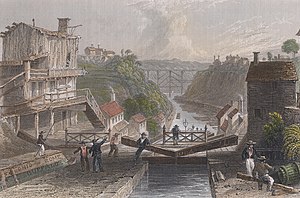The United States creates some of the world's most innovative products, dominating brands and profitable business models, exporting them around the globe with tremendous success.
Of the world's 100 most valuable brands, 62 are American, according to Interbrand, a consulting group that annually evaluates products. It's a fair accomplishment for a country that produces less than one-third of the world's economic output.
| |
The successes of companies such as Coca-Cola, McDonald's and Apple create wealth and jobs in the United States and overseas. But American brands also generate resentment, copycats and fierce competition.
Business and commerce is one arena where the world is increasingly "American." This series examines nonmilitary, nonpolitical aspects of this pervasive U.S. influence — from democratic ideals and entrepreneurial ingenuity to language, sports and popular culture — and some of the consequences of this influence.
The United States is the world's leading exporter and importer, and its companies spend more money establishing and expanding overseas operations than those of any other nation.
In 2003, U.S. exports of merchandise and commercial services totaled $1.01 trillion, according to the World Trade Organization (WTO). Top exports include $46.1 billion in semiconductors, $31.3 billion in computer accessories, $36.2 billion in vehicle parts, $22.1 billion in cars, $23.3 billion in civilian aircraft and $20.5 billion in pharmaceuticals, according to 2003 Commerce Department statistics.
The United States plays another important role as the world's largest market, with free-spending consumers looking for good deals on quality products.
U.S. imports of merchandise in 2003 more than doubled those of the second-leading country. Consumers and companies bought $1.3 trillion in goods and an additional $229 billion in services, the WTO says.
"The U.S. is the locomotive for global growth. If we were not providing that stimulus, it seems quite possible that the rest of the world economy would slip back into recession," says Kent Hughes, director of the America and the Global Economy Project at the Woodrow Wilson Center.
More than a market
American consumers are not just a market; they are an entire business model for some companies.
"It's 100 percent [that] we sell in the United States," says Ziad Salah, commercial and finance manager for United Garment Manufacturing Co. The Amman, Jordan, company makes pants, jackets and other clothes and sells them to retailers such as Wal-Mart and Target.
The enterprise employs 750 workers. Each of the 300,000 garments made every month goes to the United States.
"If the U.S. market is open, it will create more opportunity and employ a lot of people — it will reduce unemployment in Jordan," Mr. Salah says.
But America's role as the world's most voracious consumer may not be sustainable.
The U.S. current account deficit, the broadest measure of trade, hit $164.7 billion in the third quarter of 2004. The figure represents 6 percent of U.S. economic output and is a record. The deficit is financed by borrowing from abroad and foreign investment in the United States.
Continuing deficits has made the United States the world's leading debtor. Other nations held almost $2.7 trillion in government and private U.S. securities, stocks, bonds, cash and other assets at the end of 2003, according to the Bureau of Economic Analysis. That position is expected to worsen.
"A quarter of a century ago, the United States was still the largest net lender on earth; 20 years ago, its global assets still exceeded its liabilities. Today, however, its net investment position is sinking below negative $3 trillion," Peter G. Peterson, chairman of the Council on Foreign Relations and a Nixon administration commerce secretary, writes in the September-October issue of Foreign Affairs. "Americans may hope that the rest of the world will go on lending unlimited funds forever. That wish, however, is unrealistic."
Mr. Peterson says the United States must export more and save more while the rest of the world must import more and consume more, an adjustment that requires substantial shifts of labor, capital and culture.
"Although no one can predict how the current imbalance in the global economy will play out, trade economists marvel at just how many ways this lopsided flywheel can spin off the axle," Mr. Peterson says.
Investing abroad
Even as the rest of the world finances American consumption, U.S. companies invest more than their counterparts from other nations in new operations abroad.
U.S. foreign direct investment was $1.3 trillion from 1994 through 2003, according to the Organization for Economic Cooperation and Development (OECD). Britain was next, with $878 billion.
The OECD argument, which has its critics, is that foreign investment brings higher wages and introduces new technologies and managerial skills to developing countries. The investments contribute to rising prosperity and create demand for exports from wealthy economies, it says.
Until 2003, the United States also was the world's leading recipient of foreign investment. But dollar figures are dropping, from $321 billion during 2000 to $39.9 billion last year.
China and Hong Kong together received $66 billion, the OECD said, knocking the United States off its perch as the world's top destination for foreign investment.
Aspiring countries hope to surpass the United States in other areas as well. And many believe that the United States — because of its trade deficit, budget deficit and an unpopular war in Iraq — is particularly susceptible to competition.
"Most astute people around the world realize that America is very vulnerable. Its economy is held together by the ability to attract investment and capital. The whole of the American system, which has been a glowing success story, it could come to an end very quickly," says Kalle Lasn, editor in chief of Adbusters, a counterculture magazine that encouraged boycotts against American brands after the U.S.-led invasion of Iraq.
"It is time for the backlash, time for the American economy to get its comeuppance," says Mr. Lasn, a native Estonian who now lives in Canada.
